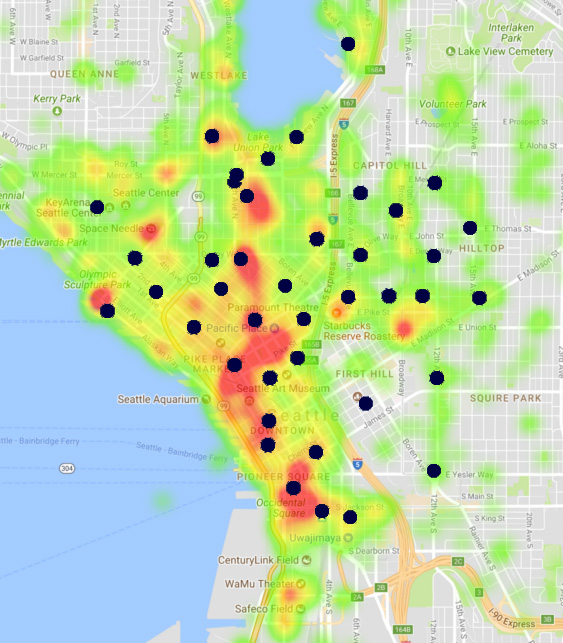Spin smashes Pronto ridership in week one, announces improved bikes
See our Seattle Bike Share Guide for an updated list of bike share companies in Seattle, links to download their apps and a quick rundown on how it all works.
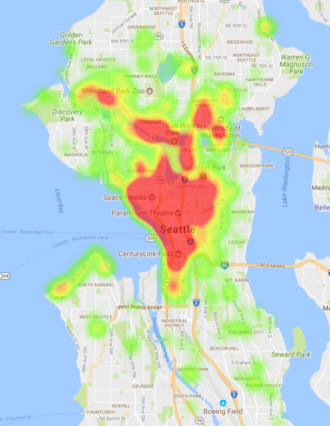
Heatmap of week one bike pickups, from Spin.
People took 5,008 rides on Spin in the company's first week operating in Seattle, 60 percent higher than Pronto's opening week in October 2014 and 300 more rides than Pronto's busiest week in its two-and-a-half year life (mid-July 2015).
And this is just a taste of Spin's vision for serving Seattle. The city's pilot permit limits the company to 500 bikes in the first month, 1,000 in month two, 2,000 in month three and then more after that if all goes well. Spin said in a press release when they launched that they hope to get to 10,000 bikes.
But this week was a great chance to learn about the power of the stationless bike share model. It's the closest thing to a bike share Pepsi Challenge we may ever get. Both Pronto and Spin had 500 bikes operating essentially exclusively in Seattle, and Spin got more rides. A week isn't an overwhelming amount of data, of course, and there are still unanswered questions about how the company is going to keep up with maintenance. But at first blush, wow. This stationless bike share thing seems to be off to a promising start. From Spin:
In week one, we're excited to share that we've hit 5,008 rides. Our average ride lasts 16.71 minutes, our top user has logged 20 rides, and an average rider has taken 2.7 trips.
The company focused most of its initial bike drops and redistribution on downtown and nearby areas, since 500 bikes is not enough to cover a wider area very well. But users can ride the bikes anywhere they want. So just about any bike outside the city center got there because someone biked it there from downtown. And people biked Spin bikes to just about every corner of the city.
Outside downtown, the Burke-Gilman Trail corridor and nearby areas obviously did very well. This is an area Pronto never served outside a small section in the U District. Pronto was supposed to expand to Fremont and lower Wallingford shortly after launching, but this never happened. So all you Pronto members who were pulling your hair out waiting for the system to serve Fremont, the Spin heatmap above vindicates you.
The heatmap also shows strong use along Alki, far away from the central neighborhoods where the bikes were initially dropped. I worry a bit about the existing beach cruiser rental businesses on Alki who have been serving the beachside trail for many years.
There are also hubs of rental activity around every Rainier Valley light rail station, especially in the area between Othello Station and Graham Street. Previous bike share efforts were very bearish on the business potential for bike share in Rainier Valley, and we have consistently pushed back against that. Spin is showing that there is demand in Rainier Valley despite the lack of quality bike lanes. The light rail stations are often located an awkward distance from major business districts and residential areas, a little long for a walk but too short to wait for a bus. Bike share is the perfect solution to this problem.
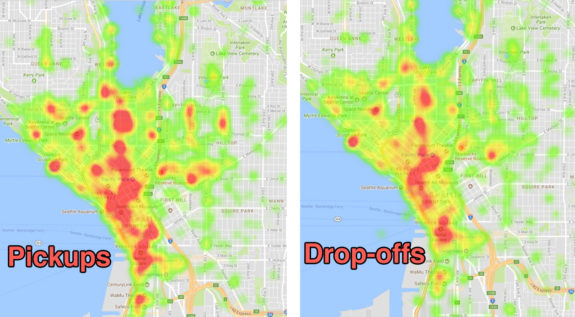
Comparing center city bike pickup and drop offs. Maps from Spin.
Zooming into the central neighborhoods where Spin has focused its initial drops, you can see that people are taking the bikes, well, basically everywhere. People are little less likely to end a trip up a big hill than they are to start one there, which is no surprise. An analysis of Pronto's ridership data by Jake Vanderplas showed that for every ten trips downhill, four or five came back uphill.
But the wide distribution of drop off locations further demonstrates an advantage of the stationless model. People are going to all kinds of places, and if you don't have a very dense network of stations, then you're simply not serving people's trips. And if you don't serve someone's trip, they aren't going to choose to use your service. That's pretty simple.
Below, I overlayed the Spin drop-off heatmap with the old Pronto station locations. The Pronto team didn't do a terrible job getting close to the hot spots, but the stations are rarely in the middle of the hottest areas. It might look good a map, but in practice this means stations were often just out of view of these epicenters of activity (including transit tunnel entrances). This was a common complaint about Pronto, and it seems that this map backs up those complaints.
But stationless bike share also serves all those yellow and green areas between the red areas, which add up to a good number of rides. Pronto would have needed a lot more stations to effectively serve all the destinations Spin now serves.
And, again, this is just a taste of what the new bike share industry has to offer Seattle. LimeBike is set to launch its 500 bikes by the end of the week, culminating in a kickoff event they're calling LimeRide all day Saturday (as advertised on Seattle Bike Blog). UPDATE: LimeBike started distributing their bikes en masse Tuesday, so check them out.
And two more companies, VBikes and ofo, have submitted bike share applications to SDOT. If they are approved, they could add an additional 500 bikes each in coming weeks. Then Spin and LimeBike will be able to increase their fleets to 1,000 each August 7. So the current Spin experiment is a mere fraction of the number of bike share bikes the city could have in service just a couple weeks from now.
People still thinking about these companies as just a replacement for Pronto are missing the big picture. If these companies succeed how they think they will, we're on the verge of a major non-motorized transportation revolution in our city. This is also why so many people can't figure out how these companies will make money. They don't yet get the scale these companies believe they can reach. $1 for a ride sounds too cheap. But at a large enough scale, it could add up fast.
The bike share business model is based on the idea that the more bikes there are, the more dependable the service becomes for more trips by more people. So as the companies add bikes, the number of trips should increase at an even faster rate. This increase should continue until some point where adding bikes no longer gains more trips. That's the city's saturation point. Nobody knows what this number is, but these companies believe it is far beyond Pronto's wildest expansion dreams.
And with enough competition, it's not hard to imagine the price dropping. VBikes and ofo, for example, advertise $1 for an hour, twice as much riding time as Spin and LimeBike offer for the same price.
Then again, Spin says the average trip during week one was just under 17 minutes, so maybe the extra time isn't such a big selling point. We may be about to find out.
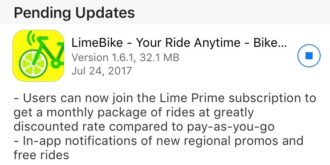 LimeBike's latest app update also hints that the company plans to offer a membership for heavy users called Lime Prime. So the membership space is another price competition point to watch for.
LimeBike's latest app update also hints that the company plans to offer a membership for heavy users called Lime Prime. So the membership space is another price competition point to watch for.
With so many companies all jumping in at the same time, it's going to be fascinating to watch how they jockey for ridership. I'm sure it will be messy at times, and I don't know how many different companies can successfully operate in the same space. Transportation departments across the U.S. are watching Seattle right now, and the companies know it. Succeeding here could be a path to getting into major markets across the nation.
Any traditional bike share system that hasn't built out a very dense network of stations should be working hard right now to figure out how to compete. Outside maybe a few extremely dense and tourist-heavy cities like New York, that old $8 for a 24-hour pass pricing model is going to get crushed by $1 rides. Maybe even giants like NYC's CitiBike are vulnerable.
Of course, this will only become an issue if the companies succeed and grow enough to expand across the country like they are planning. There are a ton of questions left to answer about their ability to keep up with maintenance and gain the level of ridership they think they can reach.
San Fransisco recently protected their recently-expanded public-private system (now called Ford GoBike, a sign that even automobile behemoth Ford sees the money in bike sharing) by passing harsh and limiting stationless bike share regulations that far exceed the regulations on the Ford-sponsored system or even on scooter and car sharing services. Their loss is Seattle's gain, because both Spin and LimeBike are Bay Area companies who are investing here first instead.
Spin is fixing bugs and building a better bikeSpin's first week hasn't been without some hiccups and bugs, which isn't surprising for any young company offering a new service like this. Readers initially reported issues using the app, especially on Android phones, but at least some of those issues appear to have been fixed. So if you had trouble last week, give it another try.
But most complaints have been about the bikes themselves. The gearing is too high to climb many of the city's hills without standing, the shifters are sometimes jammed, the brakes aren't as strong as they could be, the rear only has a reflector instead of a light (legal, but not preferred), and the headlights are flimsy and don't come on automatically unless switched on (the switch is not immediately obvious, leading some people to think the lights are broken). Also, people have started to steal the seatposts and saddles. For a buck, these aren't dealbreakers for many people (OK, the headlight and saddle are pretty important), but they are areas for improvement if the service really wants to get wider use.
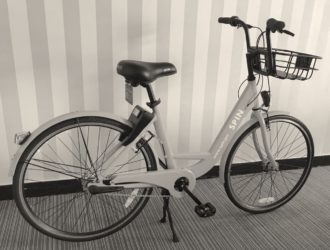
Sneak peek at the second generation Spin bike, which they are calling "Twelve." Photo from Spin.
The good news, however, is that Spin has heard these complaints and already has a second generation bike in the works for their August expansion that should address these issues. They also say they will be retrofitting their current fleet. From Spin:
Twelve is our newest Spin bike specifically designed based on your feedback, Seattle. Yes it's still orange. But among its many upgrades, here's a couple we're particularly excited about:
Gearing. For a public bikeshare, what matters most is not the number gear ratios (or "speeds"), but the individual gear ratios themselves and the reliability of the hub. We've reduced our gear 1 ratio by at least 25%, in our quest to provide the best gear ratio, whether you're riding up Capitol Hill or down 2nd.
Center mounted dual kickstands. Our new kickstand keeps our bikes upright and stable between rides.
Lights. Instead of a rear reflector, we now have a nifty new solar-powered rear light! And look forward to an all new dynamo front light, which is even more durable and stays on after you stop. Safety first.
Brakes. Our front and back brakes by Minnesota's Promax will give you even more stopping power as you zip down slopes.
Twelve hits the streets this August. We'd love your feedback once again, as we work towards the perfect bike together.
Wait, There's MoreAugust feels like forever, so we'll be upgrading our current fleet with some of Twelve's signature parts, starting this week. Our mechanics will be all around town, so drop by and say hi!
This is a very quick response to user feedback. Within a month, they plan to address a huge number of seemingly big issues with their bikes to get them right for Seattle. The ability to be nimble like this is another advantage Spin has over traditional U.S. bike share systems.
Of course, this is a game of startups. It's impossible to know who will succeed, who will fold, who will buy who and how any of this is going to be working in 6 months or a year. It's exciting and volatile. And if these companies only get half as far as they think they can, our city is going to need a hell of a lot more safe and connected bike lanes to serve the big increase in biking.
At a time when our streets are more and more clogged with cars, this private bike share movement is the only serious and immediate response to the problem happening right now. It is in everyone's best interest that these companies succeed. This is one more reason why the city needs to build the Basic Bike Network as soon as possible. Intimidating streets in our central neighborhoods remains the biggest impediment to more people biking there.
